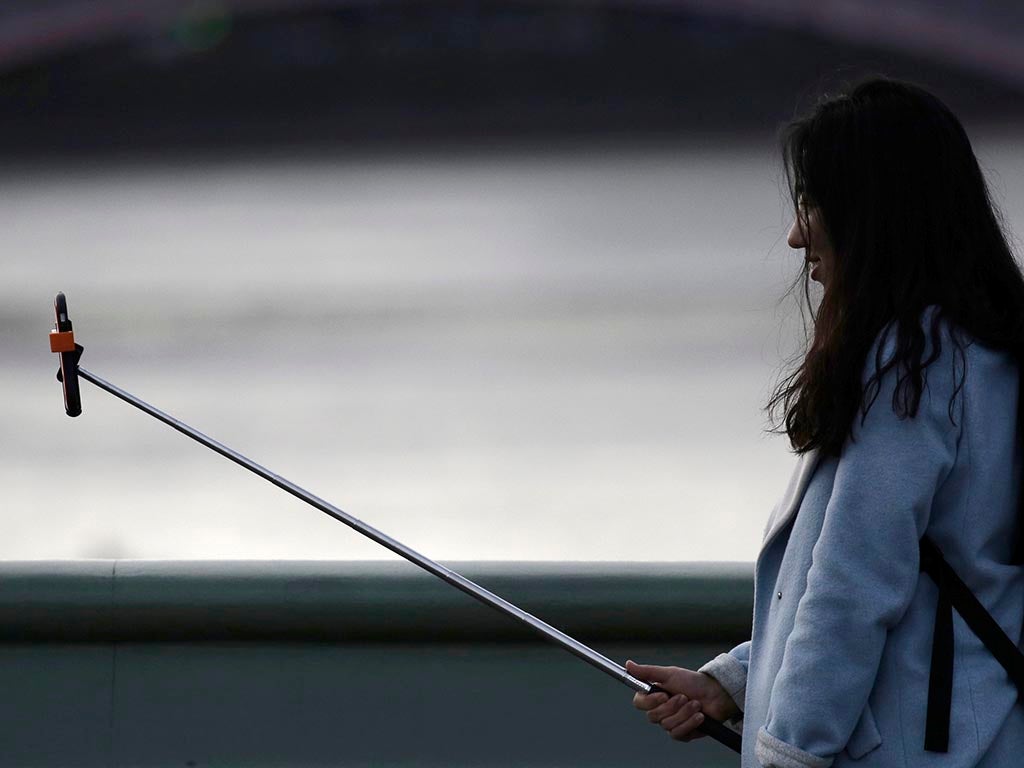The Independent's journalism is supported by our readers. When you purchase through links on our site, we may earn commission.
The danger of too many selfies: We're striving for perfection that won't come
For decades psychologists have put mirrors in labs to understand what happens psychologically when we look at ourselves. The first experience is self-consciousness, the second is comparison – Am I all that I should be? And the answer is often no. It's the age of narcissism, anxiety...and the selfie stick

Putting camera equipped smartphones in the hands of a billion plus people has turned us all into mini-reporters. And one of the main things we report on is our own face. The result is over a million so-called selfies taken and shared every day. We now have special selfie sticks that we can use to hold our phones away from us for better pictures. These have become so popular so quickly that they are now being banned at many cultural sites. And selfies are even popping up in the darkest of places, including funerals and terrorist attacks.
Does this matter? Is there any harm in this selfie swarm beyond mild bemusement? It is a new form of communication, but it seems to be an old message of connection. If a child sends a selfie to her grandmother and makes her smile, the world is probably a better place. And if two friends swap images of each other making goofy faces during a boring day at school, it seems like a decent way to lighten the mood and share the pain.
However, many selfies are driven by the twin forces of arrogance and anxiety. Like a dog chasing its tail, this is how much of our society now works. One group – arrogant, narcissistic and self-promoting – starts a trend. The other group – anxious and wanting to fit in – follows.
People who are narcissistic report sending the most selfies. This gets them attention and probably feels good – it you think you are hot, seeing your hotness broadcast to your social network is a positive experience. And this isn’t too surprising; it is the same pattern that appears in other social media, with narcissism predicting self-enhancing Facebook photos and number of Twitter posts.
The greater dangers from selfies are found on the anxiety side. For decades research psychologists have put mirrors and cameras in laboratories to understand what happens psychologically when we look at ourselves. The first experience is self-consciousness – we become aware of ourselves as objects. The second is comparison – we compare ourselves to our ideal standards. We think: Am I all that I should be? And the answer for many of us is no – with the result being anxiety.
This can be a problem with real consequences. In one well known study, for example, women who wore a swimsuit in front of a mirror reported body shame, restrained eating and impaired cognitive performance on math problems. This was done in the pre-selfie era, but my hunch is that the results would be similar with selfies: self-consciousness and a potentially destructive desire to look better.
How does this work in the real world? We are living in a culture surrounded by selfies. The people posting most frequently tend to be narcissistic and self-promoting. They also are typically not images that represent attractiveness honestly.
People who want to look good master the art of the selfie. Kim Kardashian, who is a true selfie professional, reportedly takes upwards of 300 selfies to get just the right one to post. Celebrity selfies are often enhanced by professional make-up and lighting. When you sit on a TV set, you have enough make-up on to make a cadaver look good.
When the rest of us take a selfie, though, it is amateur hour. If we study our image too closely it is clear that we are really not as attractive as we should be – definitely not as attractive as the people whose selfies we see most often. Our faces are probably a little lopsided, our skin is a bit blotchy, we have a few more wrinkles than we thought, and we think we look fat.
So what happens next? When we feel bad, we try to change. We can try some of the filters available on various sites to even out our skin tone. Or we can go the Kim Kardashian route and take scores of selfies until we get it right. But she is a pro and selfies are her job – we should have better things to do. The more drastic option is plastic surgery or other cosmetic treatments. Selfies are apparently driving people to seek plastic surgery.
The good news is that other people don’t critique our appearance as much as we think they do. They are too busy worrying about their own issues. Psychologists call this the spotlight effect.
Here is the other good news. The world is really interesting. We should have fun sending selfies to our friends or family, but not get so sucked into our appearance that we miss the world around us.
W. Keith Campbell is co-author of The Narcissism Epidemic and a professor of psychology at the University of Georgia. wkeithcampbell.com, @narcissismsci
Join our commenting forum
Join thought-provoking conversations, follow other Independent readers and see their replies
Comments